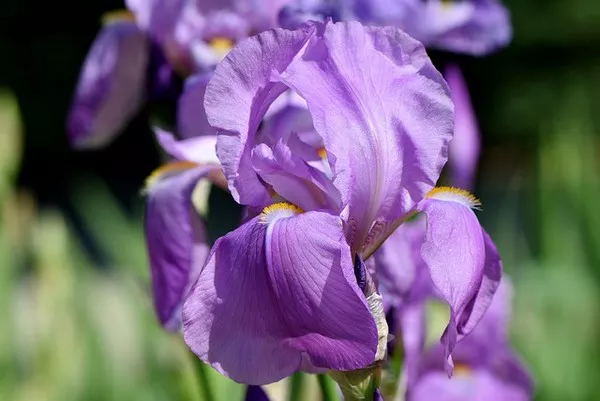The iris flower, with its intricate beauty and rich symbolism, has captivated humanity for centuries. Renowned for its vibrant hues and elegant form, the iris transcends mere botanical significance, embodying a tapestry of meanings across cultures and epochs. In this comprehensive exploration, we delve deep into the essence of the iris, uncovering its multifaceted symbolism, botanical characteristics, and enduring cultural significance.
The Botanical Marvel: Unraveling the Iris
Before delving into its symbolic meanings and cultural significance, it is essential to appreciate the iris from a botanical perspective. Belonging to the genus Iris within the Iridaceae family, the iris encompasses over three hundred species, each boasting distinctive characteristics and habitats. These perennial herbs are renowned for their striking flowers, characterized by six petals arranged in a unique pattern of three drooping downward, known as falls, and three arching upward, called standards.
The iris’s diverse species are distributed across various geographical regions, from temperate climates to arid landscapes, thriving in habitats ranging from moist woodlands to arid deserts. Despite this diversity, irises share common botanical features, including sword-shaped leaves, rhizomes or bulbs for propagation, and intricate floral structures adapted for pollination by insects.
Symbolism in Bloom: Decoding the Language of the Iris
Throughout history, the iris has served as a powerful symbol, imbued with layers of meaning that transcend its botanical attributes. One of the most prevalent symbolic associations of the iris is with the Greek goddess Iris, messenger of the gods and personification of the rainbow. In Greek mythology, Iris was revered as the link between heaven and earth, her rainbow-hued cloak symbolizing divine communication and transcendence. Consequently, the iris became emblematic of communication, messages, and the passage between worlds.
Furthermore, the iris’s association with the rainbow underscores its symbolism of hope, renewal, and transformation. Just as the rainbow emerges after the storm, the iris blooms in a kaleidoscope of colors, heralding the arrival of spring and the promise of new beginnings. This symbolism is particularly evident in the Japanese iris, where it is revered as a symbol of courage and protection against evil spirits.
Beyond its association with mythology and natural phenomena, the iris holds deep-rooted symbolic meanings in various cultures and traditions. In ancient Egypt, the iris symbolized power and royalty, often depicted in hieroglyphs and used in funerary rites to guide the deceased to the afterlife. Similarly, in medieval Europe, the fleur-de-lis, derived from the iris flower, became a symbol of royalty, purity, and divine favor, adorning coats of arms and regal insignia.
Cultural Reverence and Artistic Inspiration
Beyond its symbolic significance, the iris has permeated art, literature, and culture, inspiring artists and poets across generations. From Vincent van Gogh’s iconic paintings of irises to Claude Monet’s enchanting depictions of water lilies and irises in his garden at Giverny, the iris has been immortalized on canvas, capturing its ethereal beauty for posterity.
In literature, the iris often serves as a potent symbol, evoking themes of beauty, fragility, and transcendence. In Marcel Proust’s magnum opus, “In Search of Lost Time,” the narrator’s encounter with a cluster of irises triggers a flood of memories, serving as a metaphor for the elusive nature of time and memory. Similarly, in Japanese haiku poetry, the iris symbolizes the ephemeral beauty of nature, celebrated in seasonal verses known as kigo.
Moreover, the iris’s cultural significance extends beyond the realms of art and literature, permeating religious rituals, folklore, and horticultural traditions. In Christianity, the iris is often associated with the Virgin Mary, symbolizing her purity and grace. In Eastern cultures such as China and Japan, irises are revered for their auspicious symbolism, believed to bring prosperity, protection, and good fortune.
Conservation and Preservation Efforts
Despite its enduring cultural significance, many species of iris face threats from habitat loss, climate change, and overexploitation. As human activities continue to encroach upon natural habitats, numerous iris species are classified as endangered or vulnerable, necessitating urgent conservation efforts to safeguard their genetic diversity and ecological integrity.
Botanical gardens, research institutions, and conservation organizations play a pivotal role in preserving rare and endangered iris species through ex-situ conservation initiatives, such as seed banking, propagation, and reintroduction programs. Furthermore, raising public awareness about the importance of biodiversity conservation and sustainable land management is crucial for fostering a culture of environmental stewardship and ensuring the survival of irises and other threatened plant species for future generations.
Conclusion
In conclusion, the iris flower transcends its botanical origins, embodying a rich tapestry of symbolism, cultural significance, and artistic inspiration. From its ancient associations with mythology and royalty to its enduring presence in art, literature, and horticulture, the iris continues to captivate and inspire humanity across cultures and epochs.
As stewards of the natural world, it is incumbent upon us to cherish and protect the irreplaceable beauty and biodiversity embodied by the iris and other flowering plants. Through concerted conservation efforts, sustainable land management practices, and a deep appreciation for the intrinsic value of nature, we can ensure that the iris flower continues to bloom as a symbol of hope, renewal, and transcendent beauty for generations to come.


